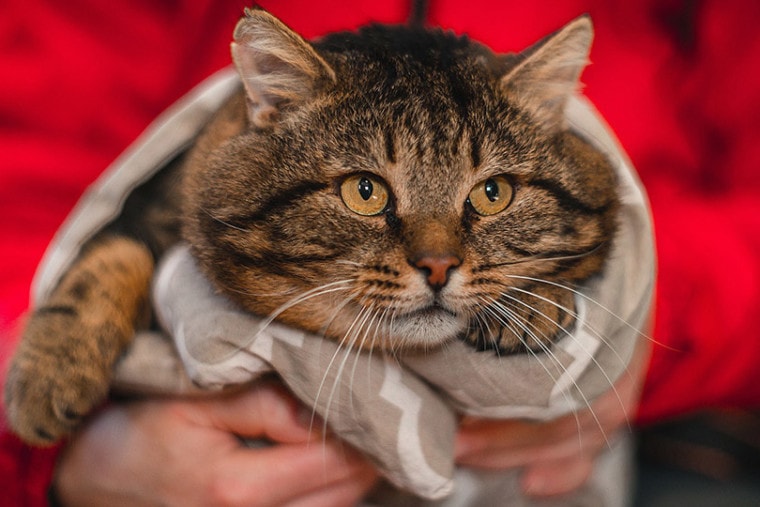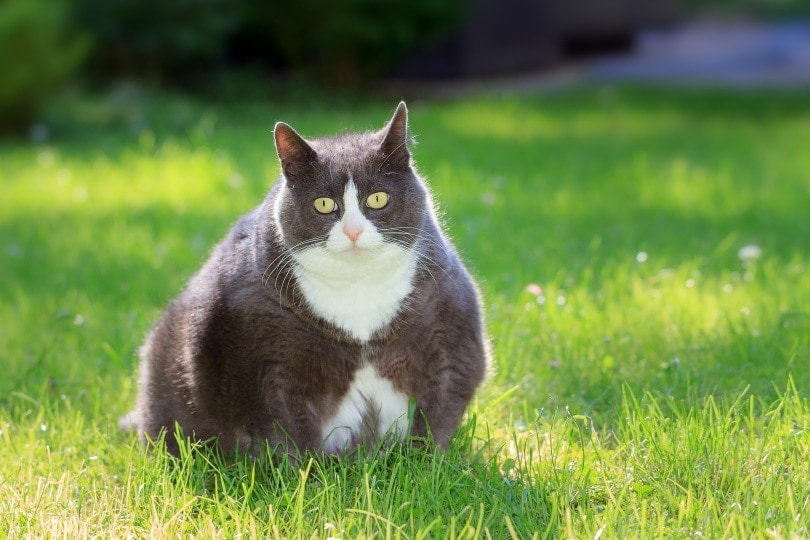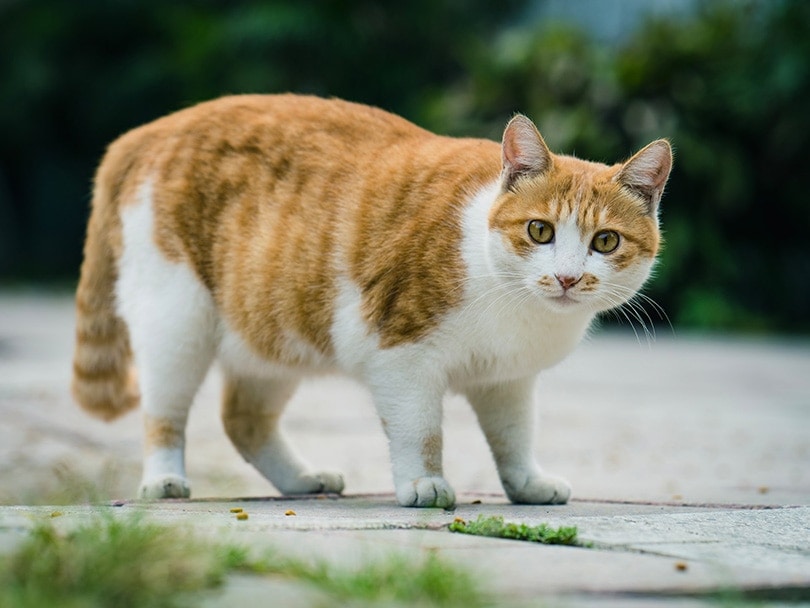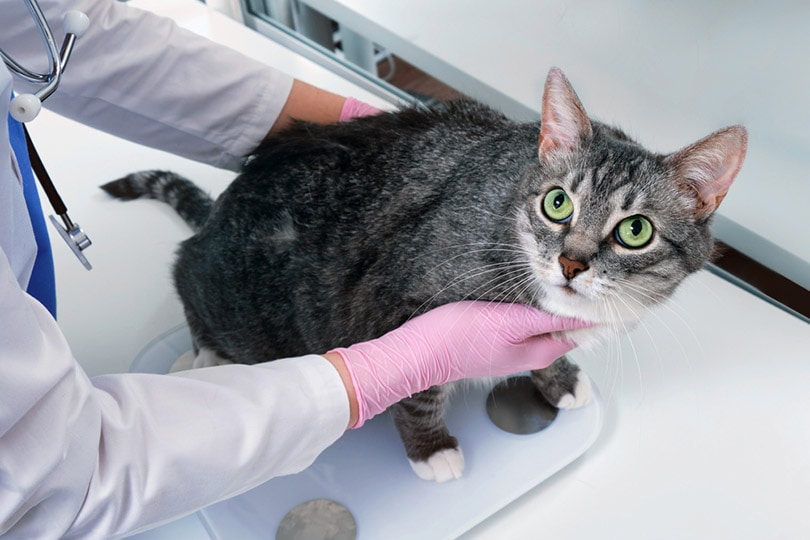
Being overweight is a condition that has serious health consequences. Today, obesity is an epidemic not only for humans but also for our pets, and cats are the most affected. Having evolved from magnificent wild predators that spent hours climbing and running for their prey, our domestic cats have become sofa decorations whose plates are always full. So, it’s no surprise that many are suffering from this condition.
There is even a trend for obese cats on social media, with many obese cats starring in TikTok videos carried around in strollers demanding food. Many people find them cute and funny, but in reality, these document overweight animals that are suffering. As responsible owners, we should aim for our cats to thrive, live healthy and happy lives, and be able to perform the natural behaviors of their species such as jumping, climbing, and even grooming themselves. Let’s take a look at how to help your cat shed the extra weight that may be stopping them from enjoying their day-to-day life.
Health Problems Linked to Cat Obesity
An overweight cat is guaranteed a shorter than normal life span and will likely develop one or more of the following diseases:

The Ideal Cat Body
It is not always easy to know if a cat is overweight, and with the variety of breeds and sizes, there is no single rule with regards to the ideal cat weight. However, veterinarians have developed a specialized score system with specific cues that help us determine the body condition of a cat. We use a grading system that ranges from 1 to 9 to help us determine the body condition of a cat.
In this way, a cat is judged by physical appearance and the absence or excess of muscle and fat and not just by a number on the scale.
Once you know what score your cat falls into, the next step is to determine their current weight. This could be done at a veterinary clinic, but you can also easily weigh your cat at home by first weighing a cardboard box he likes to play in, then weighing him inside the box, and subtracting the weight of the box itself.
Improve your cat’s dietary health with our convenient calorie calculator here:
The exact amount of calories an individual animal needs to maintain a healthy weight is variable and influenced by many factors including genetics, age, breed, and activity level. This tool is meant to be used only as a guideline for healthy individuals and does not substitute veterinary advice
Slow and Steady
Now that you know that your cat needs to drop some pounds, it is very important to understand that this needs to be done slowly and gradually. A cat that loses weight too fast can develop a very dangerous condition known as fatty liver disease or hepatic lipidosis. In this condition, the cat breaks down fats too fast, overwhelming the capacity of the liver to process them, so the fat ends up being stored by the liver. This results in damage to the tissue and compromised liver functions.
This is very dangerous and the more fat that your cat has stored, the greater the risk if the diet restriction is too dramatic. Because of this, when getting your cat to lose weight, slow and steady wins the race. You should aim to help your cat lose only between 1%-2% of their body weight per week. Any weight loss greater than that puts your cat’s health at risk, so a cat’s weight loss journey should be incremental with small caloric restrictions planned and adjusted over a long period.

The Honest Truth About Feline Obesity
Now that you have understood that your cat needs to lose weight to be healthy and to do this safely, it must be done gradually, it is time to make an evaluation on the current reasons why your cat has been gaining unhealthy weight.
The first step is to determine the number of calories your cat has been consuming daily and this includes the food plus the treats. This might be hard to tally, especially if you have been allowing your cat to free feed—a setup in which cats are given dry food left on their plates all day and owners just keep filling up their plates every time it is empty. Many cats that are fed in this way end up eating more than they would normally, sometimes out of boredom, sometimes out of habit. In short, it’s an unsustainable way to keep your cat fed.
If this is your current setup, you will need to pay attention to the exact amount of food your cat eats in a day and measure it. The calories per cup or ounce vary in each specific cat food formula but they should be clearly instructed on the label.
If you regularly feed your cat treats as well, you need to add the calories from those as well for an accurate daily caloric total.
Go See the Vet
Now that you know the number of calories your cat has been consuming daily, it is recommended to get the cat checked by the vet to rule out the presence of any health issues besides obesity. Cats tend to mask disease and it is not very obvious to humans until it is well advanced.
A healthy cat’s weight loss should be done carefully, so a cat with a specific health condition will require even more care. The veterinarian should be able to support the cat’s weight loss process and evaluate if there are any specifics of the case that need to be addressed. Sharing the total number of calories your cat eats daily with your vet will also help them offer you the best suggestions for weight loss success.

Less Is More
Decreasing the total number of daily calories your cat consumes every day by 20% should be a good starting point. Every cat’s metabolism is different. Noting your cat’s weight every week should help you evaluate their progress and make sure you are staying between the recommended 1%-2% of body weight lost weekly. If a cat lost less than 1% body weight with a caloric restriction of 20% during the week, you can restrict 25% next week and reevaluate. Likewise, if the cat lost more than 2% body weight with a caloric restriction of 20%, you should slow things down and cut the calories only by 15% next week.
High-quality cat food is an important part of fostering a long and healthy life for your cat but the right cat food and water dish will promote good posture, offer whisker relief, and aid in good digestion. The Hepper NomNom Cat Bowl is our favorite bowl since it offers all of the above and is beautifully crafted to meet modern home stylings. The wide tray design catches any food and water spills and the entire setup is dishwasher safe. Learn more about the Hepper NomNom Cat Bowl here.
At Pet Keen, we’ve admired Hepper for many years and decided to take a controlling ownership interest so that we could benefit from the outstanding designs of this cool cat company!
Implement a Change of Habits
If your cat is used to having a full plate always available, we recommend stopping this habit and getting the cat used to eating three times a day, at least initially. Give your cat 30 minutes to eat their food and then remove the plate. This will help you control the daily food allowance of the cat and it will also get rid of eating fueled by boredom. Cats are creatures of habit and you might find your cat is moody for a few days, but for cats that overeat when free-feeding, it is very important to help them adapt to a feeding schedule.
Increase Food Quality
Almost all dry cat foods in the market are higher in carbohydrate content than is necessary for cats. Most dry cat foods on the market are also low in protein. Many obese cats seem to be constantly hungry. Yes, they are always hungry simply because their nutritional requirements are never actually met. Cats are obligate carnivores; they need a diet of mostly animal-based proteins and fats and a minimal amount of carbohydrates to thrive. Most dry food delivers exactly the opposite.
There is a lot of controversy with regards to the ideal macronutrient profile of cats. Currently, the association that regulates pet food (AAFCO) has only established the minimum requirements, but no organization has established an ideal. Maintenance requirements for an adult cat, according to AAFCO, are only 26% protein and 9% fat, with no mention of carbohydrates. Experimental studies with cats that were offered the freedom to choose when given different combinations of processed cat food options show that they would consistently prefer a diet with 52% protein, 35% fat, and 12.5% carbohydrates. Moreover, if you measure a mouse’s nutritional content on a dry matter basis, the nutritional profile would be 55% protein, 45% fat, and only 1%-2% carbohydrate.
Aim to feed your cat a diet based on a good quality animal protein that better resembles a carnivore’s preference and natural diet.
Add Water
An easy way to help your cat to healthily lose weight and prevent health issues, such as chronic kidney disease, is to feed your cat a balanced diet that is high in moisture. Start gradually but have the goal to transition your cat from a dry food diet into a wet food diet. Research has found that cats on a higher moisture content diet can maintain weight loss and are even more physically active!
Come Out and Play
Playing with your pet is a wonderful way of strengthening your relationship with your cat and also a great way of increasing your cat’s physical activity. Aim for at least two 15-minute-long sessions of interactive play and you will see great benefits in your cat’s overall health. A useful tip is to time these sessions before mealtime, you can even use small pieces of the food to reward your cat for their engagement during the play sessions or just serve your cat’s meal right after the play session. Your cat will soon have a very positive association with this playtime. And this mimics the natural habit of running and hunting for they pray before enjoying the meal!
If you aren’t able to commit to these sessions due to time constraints, you should consider offering interactive toys for your cat while you’re away—preferably ones that don’t revolve around rewarding your pet with food.
Conclusion
Dietary and habit changes will greatly benefit your cat’s health. Every cat can enjoy the health benefits of being in an ideal body condition but when it comes to cat’s weight loss it is necessary to take things slowly. Analyzing the current state, habits, and diet is the first step. Small and gradual change is the best way to achieve long-lasting results. Weekly evaluations help do the necessary adjustments for a healthy way to help your cat lose weight.
You Might Also Be Interested In:
- 160 Nerdy Cat Names: Game and Geek-Inspired Options for Kittens
- Is My Cat Too Underweight? Here’s How to Tell if Your Cat is Too Skinny
Featured Image Credit: 99mimimi, Pixabay









